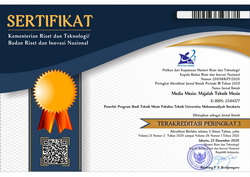REDESIGN OF OUTER HOOD PANEL OF ESEMKA R2 CAR TO IMPROVE PEDESTRIAN PROTECTION USING FINITE ELEMENT MODELING
Binyamin Binyamin(1*)(1) Universitas Muhammadiyah Surakarta
(*) Corresponding Author
Abstract
Full Text:
PDFReferences
J. Marbun, “Indonesia Urutan Pertama Peningkatan Kecelakaan Lalu Lintas,” 2014. [Online]. Available: http://www.republika.co.id. [Accessed: 03-Feb-2016].
A. Ahmed and L. Wei, “Thin-Walled Structures Introducing CFRP as an alternative material for engine hood to achieve better pedestrian safety using fi nite element modeling,” Thin Walled Struct., vol. 99, pp. 97–108, 2016.
J. Huang, Z. Liu, and Y. Long, “A Numerical Investigation of a Novel Hood Design for Pedestrian Protection,” pp. 872–878, 2014.
S. Min, H. Kim, S.-W. Chae, and J. Hong, “Design method of a hood structure adopting modal analysis for preventing pedestrian’s head injury,” Int. J. Precis. Eng. Manuf., vol. 17, no. 1, pp. 19–26, 2016.
A. Masoumi, M. Hassan, and A. Najibi, “Comparison of steel , aluminum and composite bonnet in terms of pedestrian head impact,” Saf. Sci., vol. 49, no. 10, pp. 1371–1380, 2011.
H. M. Samaka and F. Tarlochan, “Building And Performance Validating Of Adult Pedestrian Finite Element Head Model To Evaluate The Car Hood Design,” vol. 2, no. 7, pp. 44–49, 2013.
A. D. Anggono, T. W. B. Riyadi, and W. A. Siswanto, “Dynamic Explicit Finite Element Code for U-Bending Simulation and Springback Prediction,” Appl. Mech. Mater., vol. 660, no. August, pp. 337–341, 2014.
R. Krishnamoorthy, M. Takla, A. Subic, and D. Scott, “Design Optimisation of Passenger Car Hood Panels for Improved Pedestrian Protection,” vol. 633, pp. 62–76, 2013.
C. Cruz, PM; Vinyals, J., “Validation of FE-models of pedestrian protection impactor,” 2004.
M. H. Shojaeefard, A. Najibi, and M. R. Ahmadabadi, “Thin-Walled Structures Pedestrian safety investigation of the new inner structure of the hood to mitigate the impact injury of the head,” Thin Walled Struct., vol. 77, pp. 77–85, 2014.
A. Torkestani, M. Sadighi, and R. Hedayati, “Thin-Walled Structures Effect of material type , stacking sequence and impact location on the pedestrian head injury in collisions,” Thin Walled Struct., vol. 97, pp. 130–139, 2015.
Article Metrics
Abstract view(s): 402 time(s)PDF: 332 time(s)
Refbacks
- There are currently no refbacks.








